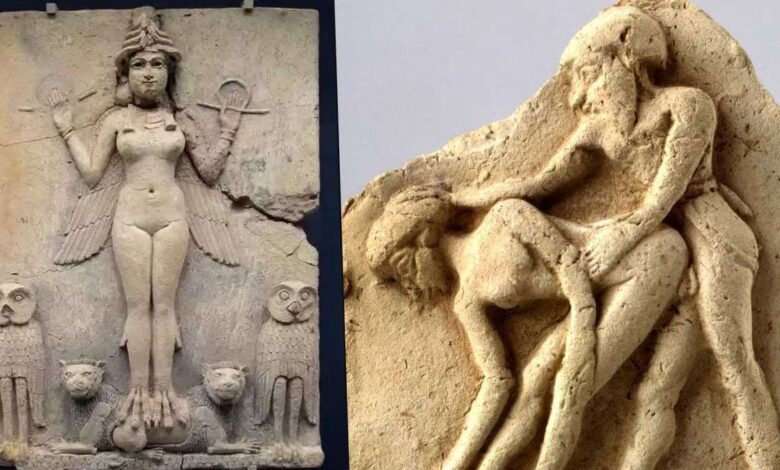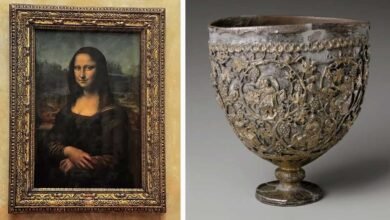
Ancient Mesopotamia, often celebrated as the cradle of civilization, was a land rich in culture, innovation, and art. Among the various artifacts unearthed from this region, there exists a fascinating and lesser-known aspect of their culture – erotic art. These relics offer us a unique window into the intimate lives of the Mesopotamian people, shedding light on their views of desire, love, and relationships.
Artifact 1: A Terracotta Tale of Desire
One of the earliest pieces in this collection is a terracotta plaque from the early 2nd millennium BCE. It portrays a man engaging in intercourse with a woman from behind. This artwork is a testament to the ancient Mesopotamians’ openness and comfort with expressing human sexuality.

Artifact 2: Where Pleasure Meets Libation

A Babylonian clay plaque from The Israel Museum takes us into a more elaborate scene. It depicts a similar intimate act but with a unique twist. The woman, while engaging in the act, is also sipping beer through a straw from a jug. This intriguing blend of sensuality and everyday life hints at the normalization of such depictions in their culture.
Artifact 3: Pleasure Amidst Revelry
From 1800 BCE, we find a portrayal of a couple engaging in intercourse while the woman enjoys a drink. This suggests a harmonious connection between lust and merriment.

Artifact 4: Love in the Missionary Position

A Sumerian plaque from 2000–1500 BCE depicts a couple in a missionary position, emphasizing the tenderness of their connection. The woman’s legs wrapped around the man symbolize the intimacy and affection in their relationship.
Artifact 5: The Enigmatic ‘Burney Relief’

Known as the ‘Burney Relief,’ this artifact from the 19th or 18th century BCE is shrouded in mystery. It is thought to represent either Ishtar, the Mesopotamian goddess of love and war, or her sister Ereshkigal, the Queen of the underworld. Its ambiguous nature invites contemplation about the intersection of love and death.
Artifact 6: Symbolism in Sumerian Pottery

A Sumerian pottery tile from the 2nd to 1st millennium BCE showcases a naked woman standing above a phallus. The symbolism in this piece invites us to ponder the deeper spiritual and erotic connections the Mesopotamians might have perceived.
Artifact 7: A Unique Blend of Sensualities

This Babylonian terracotta plaque from 2100–1500 BCE captures a man penetrating a woman from behind. What makes this piece extraordinary is the woman simultaneously sipping beer from a jug using a straw. It beautifully weaves together earthly pleasures with the intimate act.
Artifact 8: Sumerian Sensuality

Another Sumerian or Babylonian terracotta plaque from the 2nd to 1st millennium BCE portrays a similar scene of a man penetrating a woman from behind while she enjoys a drink. It reaffirms the Mesopotamians’ comfort in expressing both sensuality and everyday life.
Artifact 9: Expressing Desire Through Art

This terracotta plaque from the 2nd millennium BCE poignantly captures a man and a woman in the act of lovemaking. It’s a testament to their ability to use art to express desire and affection.
Artifact 10: An Ode to Physical Love

In another terracotta plaque from the 2nd millennium BCE, a man and a woman are entwined in an intimate embrace, celebrating the beauty of physical love.
Artifact 11: The Complexity of Human Emotions

A Sumerian clay impression from a cylinder seal, dated 6th to 4th century BC, tells a more complex story. It portrays a man who has just discovered his wife’s infidelity, highlighting the multifaceted nature of human relationships.
Artifact 12: Pleasure Amidst Beer

The final artifact in our collection, a Babylonian terracotta plaque from 2000–1500 BCE, once again features a couple engaging in intercourse. The woman is savoring her beer through a straw from a jug while the man penetrates her from behind. It captures the intertwining of sensual and everyday pleasures.
These artifacts provide a rare glimpse into the intimate aspects of Mesopotamian life. They reveal a society unafraid to express the complexity of human desires, the tenderness in relationships, and the interplay of sensuality with the mundane. While these depictions may be viewed as explicit, they offer a unique perspective on the timeless themes of love, passion, and human connection that have transcended the millennia.
Sources:
- https://sumerianshakespeare.com/748301/975601.html
- https://theconversation.com/in-ancient-mesopotamia-sex-among-the-gods-shook-heaven-and-earth-87858
- http://factsanddetails.com/world/cat56/sub363/entry-6070.html
- https://www.bidsquare.com/online-auctions/artemis-gallery/mesopotamian-terracotta-relief-plaque-w-erotic-scene-1308482
- http://store.barakatgallery.com/product/babylonian-terracotta-plaque-erotic-scene/
- https://www.bidsquare.com/online-auctions/artemis-gallery/sumerian-pottery-tile-with-erotic-scene-1146081
- https://www.ancient.eu/article/688/love-sex-and-marriage-in-ancient-mesopotamia/
- https://steemit.com/history/@kaydee100/kinky-sexual-practices-of-ancient-babylon
- http://realhistoryww.com/world_history/ancient/Misc/Sumer_additional/Sumer_add2.htm
- https://www.timesofisrael.com/4000-year-old-erotica-depicts-a-strikingly-racy-ancient-sexuality/




